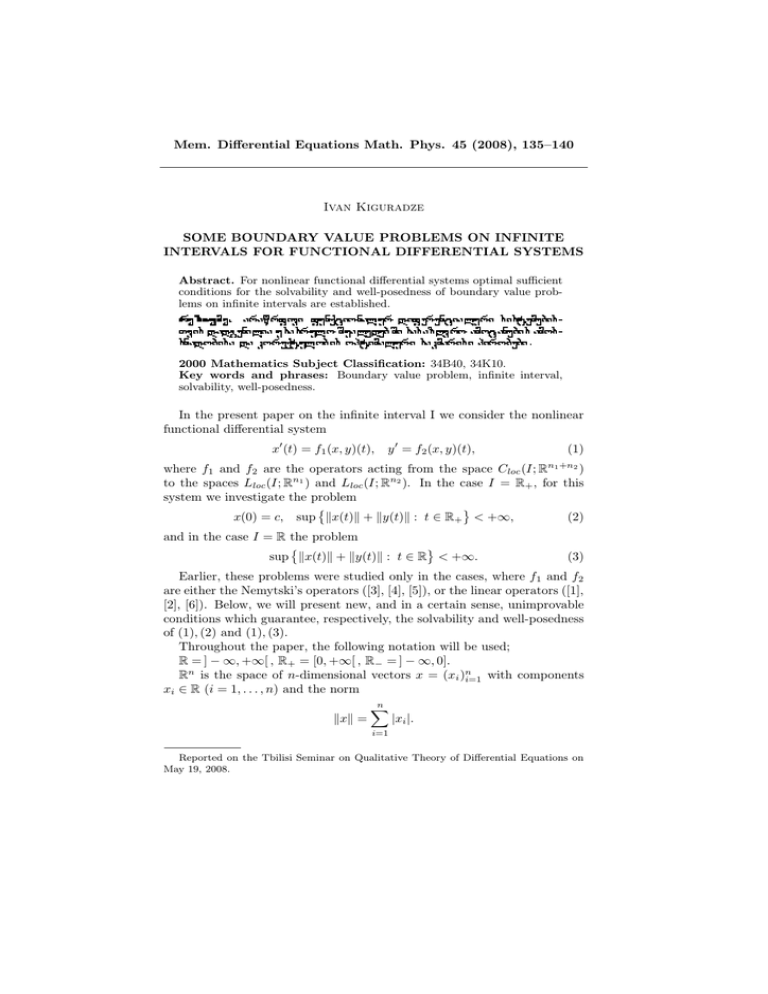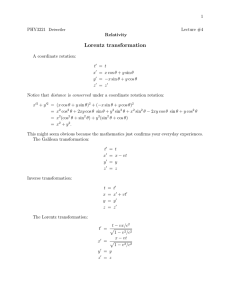Mem. Differential Equations Math. Phys. 45 (2008), 135–140 Ivan Kiguradze
advertisement

Mem. Differential Equations Math. Phys. 45 (2008), 135–140 Ivan Kiguradze SOME BOUNDARY VALUE PROBLEMS ON INFINITE INTERVALS FOR FUNCTIONAL DIFFERENTIAL SYSTEMS Abstract. For nonlinear functional differential systems optimal sufficient conditions for the solvability and well-posedness of boundary value problems on infinite intervals are established. ! ! " 2000 Mathematics Subject Classification: 34B40, 34K10. Key words and phrases: Boundary value problem, infinite interval, solvability, well-posedness. In the present paper on the infinite interval I we consider the nonlinear functional differential system x0 (t) = f1 (x, y)(t), y 0 = f2 (x, y)(t), (1) where f1 and f2 are the operators acting from the space Cloc (I; Rn1 +n2 ) to the spaces Lloc (I; Rn1 ) and Lloc (I; Rn2 ). In the case I = R+ , for this system we investigate the problem x(0) = c, sup kx(t)k + ky(t)k : t ∈ R+ < +∞, (2) and in the case I = R the problem sup kx(t)k + ky(t)k : t ∈ R < +∞. (3) Earlier, these problems were studied only in the cases, where f1 and f2 are either the Nemytski’s operators ([3], [4], [5]), or the linear operators ([1], [2], [6]). Below, we will present new, and in a certain sense, unimprovable conditions which guarantee, respectively, the solvability and well-posedness of (1), (2) and (1), (3). Throughout the paper, the following notation will be used; R = ] − ∞, +∞[ , R+ = [0, +∞[ , R− = ] − ∞, 0]. Rn is the space of n-dimensional vectors x = (xi )ni=1 with components xi ∈ R (i = 1, . . . , n) and the norm kxk = n X |xi |. i=1 Reported on the Tbilisi Seminar on Qualitative Theory of Differential Equations on May 19, 2008. 136 x · y is the scalar product of the vectors x and y ∈ Rn . m n n If x = (xi )m i=1 ∈ R and y = (yi )i=1 ∈ R , then z = (x, y) is the (m + n)dimensional vector with components zi = xi (i = 1, . . . , m) and zm+i = yi (i = 1, . . . , n). If x = (xi )ni=1 , then sgn x = (sgn xi )ni=1 . X = (xik )ni,k=1 is the n × n-matrix with components xik ∈ R (i, k = 1, . . . , n). r(X) is the spectral radius of X. C(I; Rn ) is the space of continuous and bounded on I vector functions x : I → Rn with the norm kxkC(I;Rn ) = sup kx(t)k : t ∈ I . Cloc (I; Rn ) is the space of continuous vector functions x : I → Rn with topology of uniform convergence on every compact interval contained in I. Lloc (I; Rn ) is the space of locally Lebesgue integrable vector functions x : I → R with topology of mean convergence on every compact interval contained in I. We say that the operator f : Cloc (I; Rn ) → Lloc (I; Rm ) satisfies the local Carathéodory conditions if it is continuous and for every ρ > 0 there exists a nonnegative function fρ∗ ∈ Lloc (I; R), such that kf (x)(t)k ≤ fρ∗ (t) for t ∈ I, x ∈ C(I; Rn ), kxkC(I;Rn) ≤ ρ. The vector function g : I × Rn → Rm satisfies the local Carathéodory conditions if g(·, x) : I → Rm is measurable for every x ∈ Rn , g(t, ·) : Rn → Rm is continuous for almost all t ∈ I and for every ρ > 0 there exists a nonnegative function gρ∗ ∈ Lloc (I; R), such that kg(t, x)k ≤ gρ∗ (t) for t ∈ I, x ∈ Rn , kxk ≤ ρ. A particular case (1) is the differential system with deviating arguments x0i (t) = gi t, x(t), x(τ1 (t)), y(t), y(τi (t)) (i = 1, . . . , n). (4) Everywhere below, when we will be concerned with the problem (1), (2) (with the problem (1), (3)) it will be assumed that c ∈ Rn1 and the operators fi : Cloc (I; Rn1 +n2 ) → Lloc (I; Rni ) (i = 1, 2), where I = R+ (I = R) satisfy the local Carathéodory conditions. Analogously, the problem (4), (2) (the problem (4), (3)) is considered under the assumption that c ∈ Rn1 and the functions gi : I × R2n1 +2n2 → Rni (i = 1, 2), where I = R+ (I = R) satisfy the local Carathéodory conditions. Under the solution of the system (1) (of the system (4)) on I is meant the function (x, y) : I → Rn1 +n2 with locally absolutely continuous components x : I → Rn1 and y : I → Rn2 , which almost everywhere on I satisfies this system. 137 Theorem 1. Let I = R+ (I = R) and there exist operators pi : C(I; Rn1 +n2 ) → Lloc (I; R+ ) (i = 1, 2), a nonnegative constant h0 , and a nonnegative constant matrix H = (hik )2i,k=1 , such that r(H) < 1 and for any (x, y) ∈ C(I; R n1 +n2 (5) ) almost everywhere on I the inequalities f1 (x, y)(t) · sgn x(t) ≤ ≤ p1 (x, y)(t) − kx(t)k + h11 kxkC(I;Rn1 ) + h12 kykC(I;Rn2 ) + h0 , f2 (x, y)(t) · sgn y(t) ≤ ≤ p2 (x, y)(t) ky(t)k − h11 kxkC(I;Rn1 ) − h12 kykC(I;Rn2 ) − h0 hold. The problem (1), (2) (the problem (1), (3)) has at least one solution. Remark 1. For the condition (5) to be fulfilled, it is necessary and sufficient that h11 + h22 < 2, h11 + h22 − h11 h22 + h12 h21 < 1. Remark 2. In the above-formulated theorem the condition (5) is unimprovable and it cannot be replaced by the condition r(H) ≤ 1. Corollary 1. Let for I = R+ (for I = R) all the conditions of Theorem 1 be fulfilled and +∞ +∞ Z0 Z Z p2 (x, y)(s) ds = +∞ p1 (x, y) ds = p2 (x, y)(s) ds = +∞ (6) 0 −∞ 0 n1 +n2 for any (x, y) ∈ C(I; R ). Then every solution of the problem (1), (2) (of the problem (1), (3)) admits the estimate (7) kxkC(R+ ;Rn1 ) + kykC(R+;Rn2 ) ≤ ρ kck + h0 kxkC(R;Rn1 ) + kykC(R;Rn2 ) ≤ ρh0 , where ρ is a positive constant depending only on H. Remark 3. The condition (6) in Corollary 1 is essential and it cannot be omitted. For the system (4), Theorem 1 and Corollary 1 yield the following propositions. Corollary 2. Let I = R+ (I = R), and there exist functions pi : I × R2n1 +2n2 → R+ (i = 1, 2), satisfying the local Carathéodory conditions, and nonnegative constants hik (i, k = 1, 2), h0 , h1 , h2 such that the matrix h11 h1 + h12 H= (8) h2 + h21 h22 138 satisfies the condition (5) and on the set I × R2n1 +2n2 the inequalities g1 (t, x, x, y, y) · sgn x ≤ ≤ p1 (t, x, x, y, y)(−kxk + h11 kxk + h1 kyk + h12 kyk + h0 ), g2 (t, x, x, y, y) · sgn y ≥ ≥ p2 (t, x, x, y, y)(kyk − h2 kxk − h21 kxk − h22 kyk + h0 ) hold. Then the problem (4), (2) (the problem (4), (3)) has at least one solution. Corollary 3. Let for I = R+ ( for I = R) all the conditions of Corollary 2 be fulfilled, and +∞ +∞ Z0 Z Z p02 (s) ds = +∞ p01 (s) ds = p02 (s) ds = +∞ , 0 −∞ (9) 0 where p0i (t) = inf pi (t, x, x, y, y) : (x, x) ∈ R2n1 , (y, y) ∈ R2n2 (i = 1, 2). (10) Then every solution of the problem (4), (2) (of the problem (4), (3)) admits the estimate (7), where ρ is a positive constant depending only on H. Now along with the functional differential system (1) consider the perturbed system x0 (t) = f1 (x, y)(t) + q1 (x, y)(t), y 0 (t) = f2 (x, y)(t) + q2 (x, y)(t) with the boundary conditions x(a) = c̃, sup kx(t)k + ky(t)k : t ∈ R+ < +∞ (10 ) (20 ) and (3). Let us introduce the following Definition. Let I = R+ (I = R) and pi : Cloc (I; Rn1 +n2 ) → Lloc (I; R+ ) (i = 1, 2). The problem (1), (2) (the problem (1), (3)) is said to be wellposed with the weight (p1 , p2 ) if it has a unique solution (x0 , y0 ) and there exists a positive constant ρ such that for arbitrary c̃ ∈ Rn1 , q0 ∈ R+ , and for any operators qi : Cloc (R+ ; Rn1 +n2 ) → Lloc (I; Rni ) (i = 1, 2), satisfying the local Carathéodory conditions and the inequalities |qi (x, y)(t)| ≤ pi (x, y)(t)q0 (i = 1, 2), the problem (10 ), (20 ) (the problem (10 ), (3)) is solvable and its arbitrary solution admits the estimate kx − x0 kC(R+ ;Rn1 ) + ky − y0 kC(R+ ;Rn2 ) ≤ ρ(kc − c̃k + q0 ) kx − x0 kC(R;Rn1 ) + ky − y0 kC(R;Rn2 ) ≤ ρq0 . 139 Theorem 2. Let I = R+ (I = R), c = 0, fi (0, 0)(t) ≡ 0 (i = 1, 2), and let there exist operators pi : Cloc (I; Rn1 +n2 ) → Lloc (I; R+ ) (i = 1, 2) and a nonnegative constant matrix H = (hik )2i,k=1 , satisfying the conditions (5) and (6), such that for any (x, y) ∈ C(I; Rn1 +n2 ) the inequalities f1 (x, y)(t) · sgn x(t) ≤ ≤ p1 (x, y)(t) − kx(t)k + h11 kxkC(I;Rn1 ) + h12 kykC(I;Rn2 ) , f2 (x, y)(t) · sgn y(t) ≥ ≥ p2 (x, y)(t) ky(t)k − h21 kxkC(I;Rn1 ) − h21 kykC(I;Rn2 ) hold almost everywhere on I. Then the problem (1), (2) (the problem (1), (3)) is well-posed with the weight (p1 , p2 ). Corollary 4. Let I = R+ (I = R), c = 0, gi (t, 0, 0, 0, 0) ≡ 0 (i = 1, 2), and on the set I × R2n1 +2n2 the inequalities g1 (t, x, x, y, y) · sgn x ≤ ≤ p1 (t, x, x, y, y) − kxk + h11 kxk + h1 kyk + h12 kyk , g2 (t, x, x, y, y) · sgn y ≥ ≥ p2 (t, x, x, y, y) kyk − h2 kxk − h21 kxk − h22 kyk hold, where hi , hik (i, k = 1, 2) are nonnegative constants, and pi : I × R2n1 +2n2 → R+ (i = 1, 2) are functions, satisfying the local Carathéodory conditions. Let, moreover, the matrix H and the functions p0i (i = 1, 2), given by the equalities (8) and (10), satisfy the conditions (5) and (9). Then the problem (4), (2) (the problem (4), (3)) is well-posed with the weight (p1 , p2 ). Acknowledgement This work is supported by the Georgian National Science Foundation (Grant No. GNSF/ST06/3-002). References 1. R. Hakl, On bounded solutions of systems of linear functional differential equations. Georgian Math. J. 6 (1999), No. 5, 429–440. 2. R. Hakl, On nonnegative bounded solutions of systems of linear functional differential equations. Mem. Differential Equations Math. Phys. 19 (2000), 154–158. 3. I. Kiguradze, Boundary value problems for systems of ordinary differential equations. (Russian) Itogi Nauki Tekh., Ser. Sovrem. Probl. Mat., Novejshie Dostizh. 30 (1987), 3-103; English transl.: J. Sov. Math. 43 (1988), No. 2, 2259–2339. 4. I. Kiguradze, On some boundary value problems with conditions at infinity for nonlinear differential systems. Bull. Georgian National Acad. Sci. 175 (2007), No. 1, 27–33. 5. I. Kiguradze and B. Půža, On some boundary value problems for a system of ordinary differential equations. (Russian) Differentsial’nye Uravneniya 12 (1976), No. 12, 2139–2148; English transl.: Differ. Equations 12 (1976), 1493–1500. 140 6. I. Kiguradze and B. Půža, Boundary value problems for systems of linear functional differential equations. Masaryk University, Brno, 2003. (Received 30.05.2008) Author’s address: A. Razmadze Mathematical Institute 1, M. Aleksidze St., Tbilisi 0193 Georgia E-mail: kig@rmi.acnet.ge




